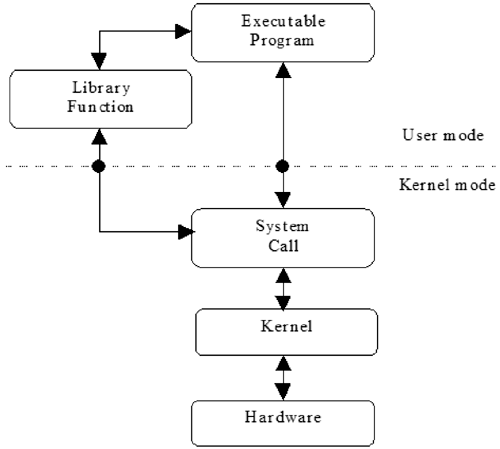System Calls
Some previously defined functions used by programs are actually system calls . While resembling library functions in format, system calls request the operating system to directly perform some work on behalf of the invoking process. The code that is executed by the operating system lies within the kernel (the central controlling program that is normally maintained permanently in memory). The system call acts as a high/mid-level language interface to this code. To protect the integrity of the kernel, the process executing the system call must temporarily switch from user mode (with user privileges and access permissions) to system mode (with system/root privileges and access permissions). This switch in context carries with it a certain amount of overhead and may, in some cases, make a system call less efficient than a library function that performs the same task. Keep in mind many library functions ( especially those dealing with input and output) are fully buffered and thus allow the system some control as to when specific tasks are actually executed.
Section 2 of the manual contains the pages on system calls. Issuing an apropos command similar to the one previously discussed but using the value 2 in place of 3 will generate synopsis information on all the system calls defined in the manual pages. It is important to remember that some library functions have embedded system calls. For example, << and >> , the C++ insertion and extraction operators, make use of the underlying system calls read and write .
The relationship of library functions and system calls is shown in Figure 1.4. The arrows in the diagram indicate possible paths of communication, and the dark circles indicate a context switch. As shown, executable programs may make use of system calls directly to request the kernel to perform a specific function. On the other hand, the executable programs may invoke a library function, which in turn may perform system calls.
Figure 1.4. Hardware and software layers .

![]()
Programs and Processes
- Introduction
- Library Functions
- System Calls
- Linking Object Code
- Managing Failures
- Executable File Format
- System Memory
- Process Memory
- The u Area
- Process Memory Addresses
- Creating a Process
- Summary
- Key Terms and Concepts
Processing Environment
- Introduction
- Process ID
- Parent Process ID
- Process Group ID
- Permissions
- Real and Effective User and Group IDs
- File System Information
- File Information
- Process Resource Limits
- Signaling Processes
- Command-Line Values
- Environment Variables
- The /proc Filesystem
- Summary
- Key Terms and Concepts
Using Processes
- Introduction
- The fork System Call Revisited
- exec s Minions
- Using fork and exec Together
- Ending a Process
- Waiting on Processes
- Summary
- Key Terms and Concepts
Primitive Communications
- Introduction
- Lock Files
- Locking Files
- More About Signals
- Signal and Signal Management Calls
- Summary
- Key Terms and Concepts
Pipes
Message Queues
- Introduction
- IPC System Calls: A Synopsis
- Creating a Message Queue
- Message Queue Control
- Message Queue Operations
- A ClientServer Message Queue Example
- Message Queue Class
- Summary
- Key Terms and Concepts
Semaphores
- Introduction
- Creating and Accessing Semaphore Sets
- Semaphore Control
- Semaphore Operations
- Semaphore Class
- Summary
- Key Terms and Concepts
Shared Memory
- Introduction
- Creating a Shared Memory Segment
- Shared Memory Control
- Shared Memory Operations
- Using a File as Shared Memory
- Shared Memory Class
- Summary
- Key Terms and Concepts
Remote Procedure Calls
- Introduction
- Executing Remote Commands at a System Level
- Executing Remote Commands in a Program
- Transforming a Local Function Call into a Remote Procedure
- Debugging RPC Applications
- Using RPCGEN to Generate Templates and a MAKEFILE
- Encoding and Decoding Arbitrary Data Types
- Using Broadcasting to Search for an RPC Service
- Summary
- Key Terms and Concepts
Sockets
- Introduction
- Communication Basics
- IPC Using Socketpair
- Sockets: The Connection-Oriented Paradigm
- Sockets: The Connectionless Paradigm
- Multiplexing I/O with select
- Peeking at Data
- Out of Band Messages
- Summary
- Key Terms and Concepts
Threads
- Introduction
- Creating a Thread
- Exiting a Thread
- Basic Thread Management
- Thread Attributes
- Scheduling Threads
- Using Signals in Threads
- Thread Synchronization
- Thread-Specific Data
- Debugging Multithreaded Programs
- Summary
- Nomenclature and Key Concepts
Appendix A. Using Linux Manual Pages
Appendix B. UNIX Error Messages
Appendix C. RPC Syntax Diagrams
Appendix D. Profiling Programs
EAN: 2147483647
Pages: 136
